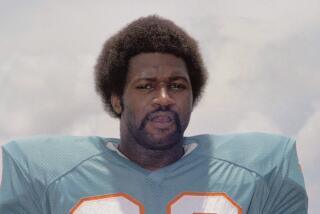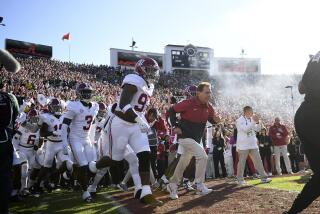Untraditional
Miami is one Rose Bowl victory from its fifth national title since 1983, not bad for a program that has more than once shared a spot on the endangered species list with the spotted owl.
There are several stories afloat regarding how close Miami came to eliminating football. In the late 1970s, it is told, the school’s board of trustees went into a meeting set on dropping football but ended up dropping basketball.
Miami remains college football’s most fascinating anomaly, a dynasty that lives paycheck to paycheck.
While Rose Bowl opponent Nebraska is fueled by remarkable consistency and legions of devoted fans, Miami has always had to feed and fend for itself.
The Hurricanes will never win any continuity contests.
Compare and contrast: Penn State has had two coaches in the last half-century, Rip Engle and Joe Paterno. Miami is working on its 11th coach since 1950, yet the program’s back beat remains as steady as anything Gloria Estefan has recorded.
Miami’s legacy is more a product of tenacity than necessity, its tradition tended by the players and coaches. Even in the halcyon years of the 1980s and early 1990s, Miami wrote gripping chapters of college football history in relative library calm.
Miami’s first national title team, in 1983, drew an average of 44,555 at the Orange Bowl, capacity 72,319.
This year’s No. 1 squad averaged 47,162 fans per game at home, 69,507 in five games on the road. As a medium-sized private school located in a diverse urban setting, Miami football is not unlike college teams vying for attention in metropolitan Los Angeles.
“I look at it the same way you look at USC,” says Oregon State Coach Dennis Erickson, who coached Miami to national titles in 1989 and 1991. “You have all those other things to do on a Saturday afternoon.”
At Miami, meeting expectations has always been tethered to meeting bottom lines.
Erickson remembers the athletic department’s financial life depended on his Hurricanes’ profitability.
“When we were there, you’d budget on us going to a major bowl or us playing on national television,” Erickson said. “That’s how you balanced the budget.”
Since fielding its first freshman squad in 1926, Miami has had more ups and downs than Dow Jones. The program withstood a hurricane that postponed the team’s inaugural game, years of ineptness, numerous coaching changes, relative indifference and the insurgence of the Miami Dolphins.
Miami produced great players--Jim Otto in the 1950s, George Mira and Ted Hendricks in the 1960s, Ottis Anderson in the 1970s--yet was late to the table in becoming a national power on par with Nebraska, Notre Dame, Oklahoma or Penn State.
Andy Gustafson went 93-65-3 from 1948 to 1963, a period labeled as the “glory years” in historical records, yet the post-Gustafson swoon led to an era that featured seven coaches in the next 16 years.
Fran Curci, an All-America quarterback for Miami in 1959, thought he could get the Hurricanes on track when he became coach in 1971, even though he arrived in Coral Gables amid rumors football might be dropped.
Curci was in his early 30s, had tons of energy, and was determined to change the attitude.
Curci thought his biggest problem was going to be playing the ambitious national schedule he inherited: Notre Dame, Alabama, Florida, Texas.
In fact, the headache was local.
“The Miami Dolphins,” he said.
The young Don Shula had fled Baltimore to lead Miami’s NFL franchise out of obscurity, leaving obscurity to the city’s college football squad.
Curci picked a bad time to go 9-13 in his two years as Miami coach, 1971 and 1972. The Miami Dolphins went to the Super Bowl both seasons, capped by a 17-0 run in ’72.
“In comes Shula, in come the Dolphins,” Curci recalls. “And bam, there he goes with his no-name guys. I had Chuck Foreman and maybe 12 kids from my team that made it to the NFL. But we can’t draw 15,000 people. We really started to lose money. I’m 33, I get an offer from Kentucky, so I leave.”
Miami’s rise would require equal parts resilience and serendipity.
A small but hard-core group of boosters fought off cries to kill the program and kept plugging away until they finally hit jackpot.
“It has to be the most remarkable story in college football over a 20-year-period,” Karl Schmitt, the school’s sports information director in the 1980s, says. “Just because of where they came from.”
There is no question Miami’s rebound began with the 1979 hiring of Howard Schnellenberger who, in a five-year span, took the team from near-extinction to a national title.
The Schnellenberger era, though, received a nice jump start by Lou Saban.
Saban went only 9-13 in his two seasons before leaving to coach at Army, but he is the man credited for first raising the talent bar. After a 3-8 season in 1977, Saban signed Miami’s first great recruiting class. He bagged 19 players from Florida but also expanded his reach to the hamlet of East Brady, Pa., where he signed a prep quarterback named Jim Kelly.
Schnellenberger, a respected assistant coach on Shula’s Dolphin staff, said he initially turned down the job offer to coach the Hurricanes.
“It was common knowledge in South Florida that the Miami program was a graveyard for coaches,” says Schnellenberger, currently trying to build a football program from scratch at Florida Atlantic.
Schnellenberger says he took the job only at his wife’s insistence. His recollection of the Miami-to-mothballs rumors had the school’s board of trustees voting to downgrade football to Division I-AA unless he took over.
“When I accepted the job, they tabled that motion for five years,” he says.
Schnellenberger walked in on a sleeping giant.
The first-year coach heard all about what was wrong with the school.
But what about that upside? Miami boasted great weather, first-class facilities, a top-notch schedule and was a stone crab’s throw from talented recruits.
“It had all the ingredients to be a great program,” Schnellenberger says.
Kelly wasn’t the only quality kid Saban left behind, either. There was also Jim Burt, Fred Marion and John Swain.
“Lou had done a good job,” Schnellenberger said of raising the talent base.
Schnellenberger had no intention of playing Kelly as a freshman. As Baltimore Colt coach, Schnellenberger nearly got Bert Jones killed playing him as a rookie.
“I didn’t want to make that mistake again,” Schnellenberger said.
But after Miami opened the 1979 season at 3-4, with a trip to Penn State pending, a desperate Schnellenberger named Kelly the starter.
Miami won the game, 26-10.
“That was the pivotal moment in the program, the absolute key,” Schnellenberger says.
Miami finished 5-6 that year, 9-3 the next, 9-2 in 1981, 7-2 in 1982 and capped the 1983 season by defeating Nebraska in a memorable Orange Bowl to claim the national title.
Miami still wasn’t drawing fans, but Schnellenberger even turned that to his advantage.
“We had to be special, to motivate ourselves, it was us against the world,” Schnellenberger said. “We appreciated the fans that did come out, but we didn’t play inspired football because of them.”
It was a mantra that would be passed down to succeeding generations of Miami players--Kelly, Bernie Kosar, Vinny Testaverde--who sold the winning formula like elixir to incoming recruits.
Schnellenberger, an assistant coach under Bear Bryant in the 1960s, had a chance to do at Miami what Bryant did at Alabama--establish his own personal legacy.
Yet, after winning the national title in 1983, Schnellenberger left to take over the Miami franchise in the United States Football League.
“Why he ever left Miami is beyond belief,” Curci says. “He could have built a dynasty that sustained itself.”
Schnellenberger doesn’t argue the point.
“Looking back on it, it was a dumb move,” he says.
Determined not to let Miami drift back to mediocrity, Athletic Director Sam Jankovich went to the plains states to nab Jimmy Johnson, the big-haired, loud-mouthed Oklahoma State coach.
“A great move,” Schmitt says. “People thought they’d hired this cowpoke guy from Oklahoma. The truth was Jimmy was very cosmopolitan. Very charismatic.”
Johnson not only kept Miami on top, he brought to the school a bravado and swagger that made the Hurricanes the Oakland Raiders of college football.
With Johnson came visages of Miami players in battle fatigues, punctuated notably by Jerome Brown’s famous pre-Fiesta Bowl quip about having to mingle with the opposition: “Did the Japanese sit down and have dinner with Pearl Harbor before they bombed her?”
Old-timers like Curci thought Johnson was a brilliant coach but loathed the bad-boy persona.
“Jimmy was probably what we needed at the time,” Curci says, “but that nasty image was outrageous and unnecessary.”
The 1986 team was probably Johnson’s best, but a 14-10 loss to Penn State cost the Hurricanes the national title.
Miami claimed its second national title the next year with a win over No. 1 Oklahoma in the Orange Bowl. After Miami went 11-1 in 1988, Johnson succeeded Tom Landry as coach of the Dallas Cowboys.
Miami football was at another crossroads, yet Jankovich kept the program moving by replacing Johnson with Washington State Coach Dennis Erickson.
Of the Hurricanes’ success, Schmitt says, “It was a combination of great hires and serendipity, having the right guy in the right place at the right time.”
Erickson directed two more national title drives, but left the program under a cloud of scrutiny that would ultimately result in NCAA probation. Miami took tremendous off-the-field hits in the 1990s, the low point coming with a Sports Illustrated cover that called for the scandal-tainted school to drop football--not that the subject hadn’t been raised before.
Miami’s dynasty appeared over when Butch Davis took over for Erickson in 1995 and inherited sanctions that would strip the program of numerous scholarships.
Curci thought the probation would cripple Miami.
“I said, ‘Oh my God, it can all go back in a second,”’ he recalls.
Once again, though, Davis proved to be the right coach at the right time, a no-nonsense disciplinarian who kept the program afloat during probation and also produced competitive teams.
Davis took Miami to the brink of a title last year before leaving in a lurch to coach the Cleveland Browns, bequeathing the program to Larry Coker, his offensive coordinator.
Coker says he spoke to Davis on the phone this week.
“He was cold in Cleveland, and I was at Disneyland,” Coker says. “He may regret that part of it. I thought he would stay with this team this year.”
No Butch? No problem.
Amazingly, the Hurricanes haven’t dropped off a bit under Coker.
Curci calls it the Miami miracle.
“A phenomenal, freak thing,” he says of the school’s success in the face of almost constant change and adversity.
Schnellenberger concurs.
“I don’t think anybody’s done what this program’s done,” Schnellenberger said.
“Especially after the sanctions.”
Schmitt left Miami in 1987. He is now senior vice president for communications at Churchill Downs Inc., yet he still marvels at what Miami has accomplished.
“The program’s been on a merry-go-round,” he says. “It had been such an average, noncompetitive program. There weren’t very many people that believed it was possible.”
(BEGIN TEXT OF INFOBOX / INFOGRAPHIC)
Miami Machine
The Hurricanes won 191 games from 1980 to 1999 compared to 278 from 1920-1979. Here’s a look:
*--*
Decade W L T Pct 1990s 92 27 0 .773 1980s 99 20 0 .832 1970s 42 67 0 .385 1960s 56 45 3 .554 1950s 60 37 3 .619 1940s 53 38 4 .654 1930s 49 35 7 .583 1920s 18 12 2 .600
*--*
(BEGIN TEXT OF INFOBOX / INFOGRAPHIC)
Hurricane Seasons
After taking over the program in 1979, Howard Schnellenberger coached the University of Miami to a national championship in 1983 behind freshman quarterback Bernie Kosar. The Hurricanes won three more titles after Schnellenberger left. Jimmy Johnson led Miami to a title in 1987 behind quarterback Steve Walsh. Dennis Erickson followed with two championships, winning with Craig Erickson in 1989 and Heisman winner Gino Torretta in 1991.
Bernie Kosar
Year: 1983
Record: 11-1
Bowl game: Defeated Nebraska, 31-30, in 1984 Orange Bowl
*
Steve Walsh
Year: 1987
Record: 12-0
Bowl game: Defeated Okalhoma, 20-14, in 1988 Orange Bowl
*
Craig Erickson
Year: 1989
Record: 11-1
Bowl game: Defeated Alabama, 33-25, in 1990 Sugar Bowl
*
Gino Torretta
Year: 1991
Record: 12-0
Bowl game: Defeated Nebraska, 22-0, in 1992 Orange Bowl
More to Read
Go beyond the scoreboard
Get the latest on L.A.'s teams in the daily Sports Report newsletter.
You may occasionally receive promotional content from the Los Angeles Times.











